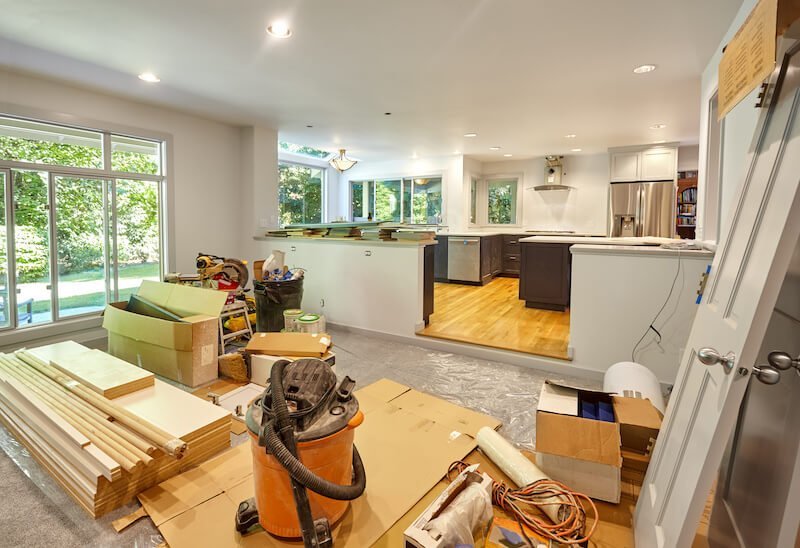
Imagine finding a charming older home in your dream neighborhood for $50,000 less than everything else on the market. It has great bones, a solid location, and just needs "a little work.
Here's what nobody tells you: That "little work" might mean living without a functioning kitchen for three months. Your $15,000 bathroom remodel could balloon to $25,000 when you discover rotted joists. Those weekends that you planned to spend relaxing may be spent at a hardware store instead.
The right fixer-upper can be a smart investment. But you'll only find it if you know exactly what you're getting into. This guide shows you the real costs, timelines, and challenges of buying a house that needs work so that you can decide if it's right for you.
For informational purposes only. Always consult with a licensed real estate professional before proceeding with any real estate transaction.
5 Questions to Ask When Buying a Fixer-Upper
- Can you afford 20% more than your renovation budget suggests?
- Do you have 6+ months before you need to move in?
- Can you handle living in a construction zone or paying rent plus a mortgage?
- Are you okay with changing plans when surprises pop up?
- Do you know the difference between DIY renovations/repairs and which need professionals?
What Actually Counts as a Fixer-Upper?
Not all fixer-uppers need the same amount of work. Understanding the difference helps you budget correctly and avoid nasty surprises.
Cosmetic Updates Only
These are the easiest fixer-uppers. The house works fine but looks dated. Think ugly wallpaper, worn carpet over hardwood floors, outdated light fixtures, and cabinets that scream 1987.
Budget for this level: Usually $15,000–$40,000. Most of this work you can do yourself if you're handy.
Moderate Repairs Needed
The house needs functional updates but isn't falling apart. Common issues include an old HVAC system that barely works, kitchen appliances from the 1990s, a bathroom that needs a full remodel, or windows that leak air.
Budget for this level: $25,000–$75,000. You'll need professionals for some of this work.
Major System Overhauls
System overhauls are the most expensive part of your renovation. The house needs serious work on core systems. Problems include electrical that's not up to code, plumbing throughout the house, a new roof, and foundation repairs.
Budget for this level: $50,000–$150,000+. Almost all of this requires licensed professionals.
Complete Gut Jobs
These fixer-uppers need everything. You're basically keeping the exterior walls and starting over. Only consider these if you have serious cash reserves and ample patience.
Budget for this level: $150,000+. Weigh the pros/cons of building a house rather than renovating this one before proceeding.
When It's Actually a Teardown
Sometimes the "fixer-upper" is too far gone. Foundation issues throughout, extensive mold, structural damage, and unpermitted additions that need removal can cost more to fix than the house is worth.
The hard truth: If three contractors tell you to walk away, listen to them.
Find Fixer-Upper Properties Before Other Buyers Grab Them
The best deals don't last long. Here's how to find fixer-upper homes first.
Working With Agents Who Know Problem Properties
Tell your real estate agent you want fixer-uppers specifically. Experienced agents know which properties have been sitting on the market and why.
They can also show you pocket listings—houses not officially listed yet. Sellers sometimes accept offers before properties hit the market.
Searching "As-Is," "TLC Needed," "Handyman Special"
These keywords in listings signal fixer-uppers. "Sold as-is" means the seller won't make repairs. "Needs TLC" is code for "this house needs work." "Handyman special" means major repairs required.
Search real estate sites using these terms to filter for fixer-uppers.
Foreclosure and Short Sale Hunting
Banks selling foreclosed properties want them gone. They'll often price below market value. Foreclosures are sold as-is with no repairs. They often require cash or fast closing. You might not get full inspections.
Short sales (where the seller owes more than the house is worth) can also give you a lower purchase price.
Driving Neighborhoods for Unlisted Properties
The absolute best deals are sometimes not listed yet. Drive through neighborhoods you like. Look for overgrown yards, peeling paint, or old "For Sale" signs. Properties that look vacant may be available.
Write down addresses, and look up owners. Make offers before the house hits the market.
What "Days on Market" Tells You
Houses that have been listed for 60+ days without selling usually have issues. Maybe they're overpriced, or maybe they need extensive work and scared off other buyers.
Use this to your advantage. Make a lower offer citing the needed repairs. Sellers who've waited months are often motivated to negotiate.
Financing Your Fixer-Upper Purchase

Regular mortgages work fine if your fixer-upper just needs paint and new carpet. However, for major renovations, you'll need special financing.
FHA 203(k) Loans Explained Simply
The FHA 203(k) government-backed loan rolls your home purchase and renovation costs into one mortgage, resulting in one closing and one monthly payment.
Two types exist:
- Limited 203(k): For repairs under $75,000, such as new flooring, updated fixtures, fresh paint throughout
- Standard 203(k): For major work, including structural repairs, room additions, and complete remodels
Requirements: Borrowers must have a minimum credit score of 580 and a down payment of 3.5%. The house must become your primary residence.
Downsides: This loan requires mortgage insurance and has more paperwork than conventional loans. Also, you must use FHA-approved contractors.
Conventional Renovation Loans
Fannie Mae's HomeStyle and Freddie Mac's CHOICERenovation loans work similarly to FHA 203(k) but with different rules.
Requirements: You’ll usually need a 620+ credit score and a down payment of 5% to 20% depending on the lender. This loan can be used for investment properties.
Benefits: No mortgage insurance is required if you put 20% down. This loan offers more flexibility in contractor choice and can include luxury upgrades FHA won't cover.
VA Renovation Loans for Veterans
If you're a veteran or active military, VA renovation loans offer benefits regular mortgages don't:
There is no down payment required and no mortgage insurance ever. This loan offers competitive interest rates and can cover purchase price plus repairs.
Limits: This loan only covers certain types of repairs. You must use VA-approved contractors and can't exceed VA loan limits in your area.
USDA Options for Rural Tennessee Properties
If you’re buying in a rural area, USDA loans might work. They cover properties in designated rural zones (which include many Tennessee towns).
Benefits: No down payment is needed. This loan has lower interest rates and can include renovation costs up to $35,000 for repairs.
Check if your property qualifies on the USDA website. Many areas you wouldn't think of as "rural" actually qualify.
Why Some Loans Are Easier Than Others
FHA 203(k) loans involve more paperwork and take longer to close. Conventional renovation loans move faster but require better credit and bigger down payments.
Most buyers choose based on what they qualify for, not what's easiest. Work with a lender experienced in renovation loans—they know the process.
The Truth About Approval Timelines
Regular mortgages close in 30–45 days. For renovation loans, plan for 45–60 days or longer.
Lenders need contractor estimates, renovation plans, sometimes architectural drawings. The property needs special appraisals.
Don't plan to close in three weeks on a fixer-upper with a renovation loan. It won't happen.
The Home Inspection: Don't Skip This (Ever)
With a fixer-upper, the home inspection isn't optional. It's critical.
Why Inspections Matter More for Fixer-Uppers
Yes, you already know you're buying a house that needs work. But the inspection tells you exactly what work, so you can get cost estimates.
Without an inspection, you're guessing. And when you guess wrong on a fixer-upper, it costs thousands.
Cost of inspection: $300–$500
Cost of discovering major foundation problems after closing: $15,000+
What Inspectors Actually Check
Professional home inspectors examine:
- Foundation and structural elements
- Roof condition and remaining life
- Electrical systems and panels
- Plumbing throughout the house
- HVAC systems
- Windows and doors
- Attic, basement, crawl spaces
They'll create a detailed report with photos showing problem areas. However, don't expect repair cost estimates in the report—you'll want to get those from a contractor.
Red Flags That Mean "Walk Away"
Some issues cost more to fix than the house is worth:
- Major foundation cracks or settling
- Extensive water damage throughout
- Mold in multiple areas
- A roof that needs complete replacement soon
- An electrical panel that's a fire hazard
- Outdated plumbing with frequent leaks
A few of these issues may be manageable, but if you identify all of them, find a different house.
Getting Specialty Inspections
Beyond the standard inspection, consider specialists for:
- Termites and wood-destroying insects
- Septic systems (if not on city sewer)
- Well water quality and pump condition
- Radon testing
- Lead paint (homes built before 1978)
- Asbestos (homes built before 1980)
- Swimming pools
These cost extra but catch problems that general inspectors might miss.
Using Inspection Results to Negotiate Price
If your inspection finds $30,000 in needed repairs, use that to negotiate. Ask the seller to reduce the price or request that they fix major issues before closing.
Most sellers won't fix everything. But structural or safety issues may often lead to price concessions.
The inspection gives you negotiating power. Use it.
The Real Costs: Add 20% to Whatever You Think You'll Spend

Your contractor gives you a quote for $50,000. Budget $60,000. Here's why.
Hidden Problems You Won't Find Until Walls Are Open
That small water stain may be rot spreading through three wall studs. The "minor" electrical update might mean that the whole panel needs replacement because it's a fire hazard.
This happens on almost every renovation. Contractors can't quote what they can't see. When demo starts, problems appear.
Permit Fees Nobody Mentions
Tennessee requires permits for most structural, electrical, and plumbing work. Each permit costs $200–$500. For a major renovation, permit costs can hit $2,000–$3,000.
Don’t skip permits to save money. You'll pay more later when the city makes you redo unpermitted work.
The "While We're At It" Syndrome
You're already ripping out the bathroom, so you might as well upgrade the shower too. And wouldn't it be so nice if those new tiles had heated floors underneath?
Small add-ons create big budget jumps. Stick to your plan or watch costs spiral.
Material Delays and Price Jumps
You budget for materials at today's prices. Then your cabinets get backordered for 6 weeks. When they finally arrive, the price has gone up 15%.
Supply chain issues and labor shortages cause delays. Prices tend to increase over time. Build some buffer room into both your timeline and budget.
Here's an all-too-realistic scenario: A homeowner budgets $50,000 for a kitchen remodel. Their demo team finds asbestos ($3,000 to remove). Plumbing doesn't meet code ($4,500 to fix). Appliances are backordered, so they decide to buy different models ($2,800 more). Final cost: $60,300.
That's normal. Plan for it.
DIY Projects vs. Call a Professional
YouTube makes every home improvement project look easy. Reality is different.
What You Can Handle
These projects don't require special licenses or extensive experience:
- Painting walls and trim
- Removing carpet
- Simple demo work (non-structural)
- Installing basic light fixtures
- Landscaping and yard work
- Refinishing wood floors (if you rent the right equipment)
- Adding backsplash tile (budget to redo it once or twice; it may take practice)
Even these "simple" projects take longer than you expect. That weekend painting project will probably take two weekends.
What Needs a Professional
Don't mess with these. Hire licensed contractors:
- Any electrical work beyond changing a light fixture
- All plumbing
- Structural changes (removing walls, adding support beams)
- Roofing
- Foundation repairs
- HVAC installation
- Anything requiring permits
Safety, building codes, and insurance are reasons why you outsource these projects. If your DIY electrical work causes a fire, your insurance might not cover it.
Permit Requirements in Tennessee
Most Tennessee cities require permits for:
- Electrical work
- Plumbing changes
- Structural modifications
- HVAC installation
- Building additions or decks
- New roof
Check with your local building department before starting work. Permit requirements vary by city and county.
When "Saving Money" Actually Costs More
If you have DIY electrical that isn't up to code, an inspector will make you hire an electrician to redo everything. You've now paid twice—once for materials and once for a professional to fix your mistakes.
Know your limits. Some projects need professionals from the start.
Renovation Planning That Won't Drive You Crazy
Random home renovations waste money and time. Strategic planning keeps projects on track.
Prioritizing Repairs: Safety and Structure First
Fix problems in this order:
- Safety hazards (electrical, gas leaks, structural issues)
- Systems that are failing (roof, HVAC, plumbing)
- Functional improvements (working kitchen and bathrooms)
- Cosmetic updates (paint, flooring, fixtures)
Fix water issues before doing any cosmetic repairs. Water damage destroys all other renovation work.
Don't paint the living room while the roof is leaking. Fix the leak first.
Creating Realistic Timelines (Then Doubling Them)
Your contractor says three months, so plan for six. Here's why:
Material delays push back installation dates. Weather delays outdoor work. Inspectors find problems that require changes. Other contractor jobs run long, delaying your start date.
Renovation timelines almost always expand. Budget extra time from the start.
Managing Contractor Schedules and Material Delays
Order materials early. Don't wait until the last minute to order cabinets, appliances, or special tiles. Many items are backordered for weeks or months.
Stay in regular contact with contractors. Weekly check-ins keep everyone on the same page. Address issues immediately instead of waiting until they become bigger problems.
Can You Live There During Construction?

Some fixer-uppers let you move in while renovating. Others don't. Understanding the difference matters for your budget and sanity.
When Living Onsite Makes Sense
If your fixer-upper only needs cosmetic work, living there works. You can use the kitchen while painting the bedrooms. The bathroom functions while you replace flooring.
Living through renovations saves money. You're not paying rent somewhere else. But, you should expect dust everywhere and disrupted routines.
When Living Onsite Is a Nightmare
Major renovations make a house unlivable. You’ll have no running water during a plumbing overhaul, no heat during HVAC replacement in January, or no kitchen for months during a full remodel.
Trying to live through this renovation process creates stress, slows down contractors, and often costs more because work has to pause for your daily life.
A Big Budget Item People Forget: Temporary Housing Costs
If you can't live in your fixer-upper during renovations, you're paying for housing twice: your mortgage payment plus rent or hotel costs.
A three-month renovation where you need temporary housing could add $3,000–$6,000 to your total costs just for rent.
Picture this: You buy a fixer-upper, planning to renovate while living there. During the first week, contractors discover the electrical system needs a full replacement. The house isn't safe to live in during the electrical work. Now, you're scrambling to find short-term housing while paying your mortgage. That "bargain" house just got more expensive.
Will You Actually Make Money on This?
Some fixer-uppers are great investments. Others are money pits. Understanding the difference protects your finances.
ARV & 70% Rule
ARV is an estimate of the home's post-renovation value. To calculate it, take the home's current value without repairs and add the renovation costs. Alternatively, use recent home sales in the area for homes comparable to your expected results as a guide—but keep in mind that the local real estate market conditions will likely change somewhat during the months of renovations.
The ARV goes hand-in-hand with the 70% rule that house flippers often use. You take the ARV, multiply it by 0.7, and then subtract the estimated repair costs. What you end up with is the maximum amount you should offer on the property.
Example: House worth $200,000 after repairs. Repairs cost $40,000. Maximum purchase price: (200,000 x 0.70) - 40,000 = $100,000.
Comparing to Similar Homes in the Neighborhood
Look at what other renovated homes recently sold for. If similar houses sell for $250,000, yours won't magically be worth $300,000 just because you love your new kitchen. Buyers won't pay a premium just because you renovated.
Your home's value is limited by the neighborhood. Buyers who can afford more than the neighborhood's typical prices usually look in more expensive neighborhoods. Overimproving your home compared to the area means you won't get your money back.
Improvements That Add Value vs. Ones That Don't
Before jumping into renovations, consider the return on investment of specific projects. High-ROI home improvements are good for resale. Low-ROI improvements should only be made for personal enjoyment of the home.
High return improvements:
- Roof replacement
- Updated kitchen (mid-grade, not luxury)
- Bathroom remodels
- Fresh paint
- New flooring
- Energy-efficient windows
- Swimming pools
- Luxury upgrades in modest neighborhoods
- Elaborate landscaping
- High-end appliances when neighbors have standard ones
Match your improvements to your neighborhood's standards.
For informational purposes only. Always consult with a licensed real estate professional before proceeding with any real estate transaction.
Is a Fixer-Upper a Good Investment?
Fixer-uppers can save you money and let you create your dream home. But they require realistic expectations, careful planning, and a financial cushion for surprises.
The best fixer-upper buyers have flexible timelines and can handle unexpected costs. You should have DIY skills or money to hire professionals. It’s important to understand that delays and plan changes are normal. Finally, you’ll need to be able to manage stress when things go wrong (and they will).
If that describes you, a fixer-upper might work great. If not, there's no shame in buying a home that's already updated.
The worst financial mistake isn't buying a fixer-upper. It's buying the wrong fixer-upper and discovering too late you can't afford to fix it.
So, do your homework: Run the numbers honestly, get thorough inspections, and budget conservatively. Then, decide if this particular fixer-upper makes sense for your situation.



